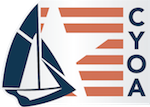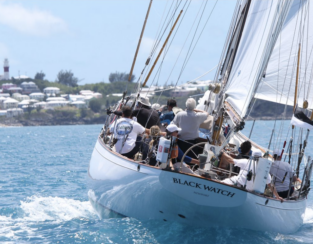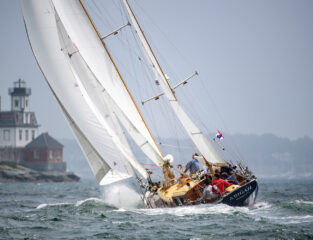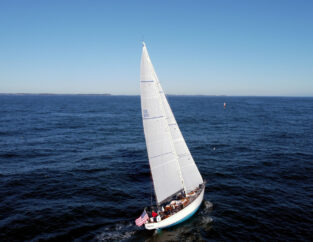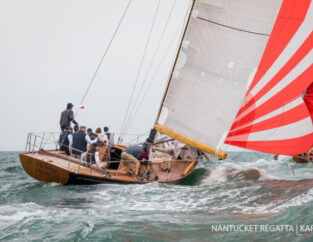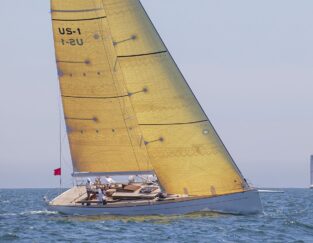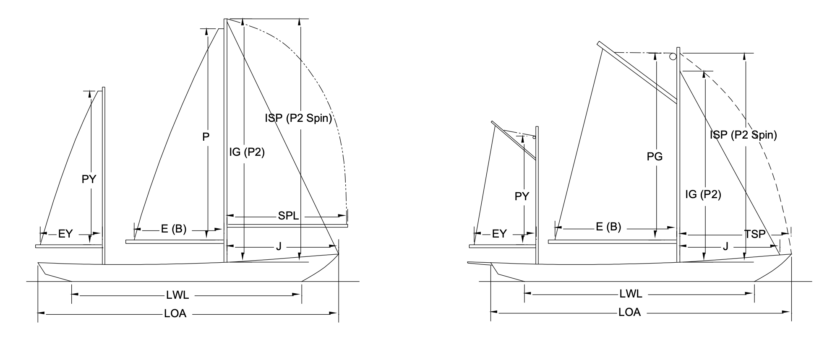Classic Rating Formula
The CRF Rating
The goal of the Classic Rating Formula (CRF) is to provide an objective, accurate and transparent rating system that is uniquely suited to scoring classic yacht races. CYOA's CRF Technical Committee routinely refines the formulae and factors used to calculate ratings annually, based on careful quantitative analysis of race results after each season. Maintaining the competitive balance within groups is a priority, but the ratings for most yachts will often change slightly from one year to the next even if the declared input data remains the same.
Each year, each vessel needs a new CRF Certificate ($50 per certificate with a $25 rush charge after June 1). Certificates only cover a portion of our operating costs and we rely heavily on volunteers. We encourage owners to also support the CYOA's efforts with a $100 membership each year.
2023 CRF Rating Documents
Classic Rating Divisions
These general definitions describe the difference in the Racing divisions. Please refer to the official definitions for further detailed explanations between the divisions. All boats are assigned a division on the CRF Certificate for which they will be scored for the overall series. Individual regattas may re-classify or group boats to fit their needs.
Frequently Asked Questions
General
A: The debate about whether ToD or ToT scoring is preferable can be endless. The reality is that ToD is simpler, it makes it much easier to monitor time allowances while on the race course, and it is more directly connected with the actual science of yacht performance predictions. At the same time, CRF is a single number rating system, and ToT scoring can give better results when the course content and/or wind conditions are well outside the rule targets, or when the conditions are unusually unsteady. When it comes to ToD vs ToT scoring, there is no one answer that best suits all circumstances. With that in mind, adding TCF’s for ToT scoring to the CRF certificate gives race organizers another tool for them to use in making informed choices that suit their own courses and conditions, as well as the preferences of their participants. For most races, ToD and ToT scoring give very similar finish positions, despite the fact that the corrected times calculated by the two systems are not directly comparable.
A: CRF converts its ratings used for Time on Distance scoring (expressed in seconds/mile) to the Time Correction Factors (TCF’s) used for Time on Time scoring via the following formula: TCF=600/(CRF+535), OR TCF=600/(CRF GPH). For example, a boat with a CRF rating of 72 (or a CRF GPH=72+535=607) would have a TCF=600/(72+535)=600/607=0.988
A: The ratings used in the familiar ToD approach to scoring follow directly from the science of sailing yacht performance prediction, in that ToD ratings reflect the time that it takes for rated boats to sail a given distance in certain conditions. These days, ToD ratings are typically expressed in seconds per mile, and corrected times (CT’s) are calculated by subtracting a time allowance (TA) for each boat relative to an arbitrary scratch boat (TA=delta rating x course length) from their elapsed time (ET). Calculated this way, CT’s for each boat are lower than their ET’s, and the boat with the lowest CT is the winner.
ToT scoring is quite different, in that instead of handicaps targeting the distance sailed as in ToD, the ToT handicaps target the time taken to complete the course. To do this, a Time Correction Factor (TCF) is established for each boat based on a conversion from her ToD handicap. TCF’s are typically targeted to have a value of 1.000 for a mythical boat that represents a fleet ‘median’. Boats that are faster than the median have TCF’s greater than 1.000, and slower boats have TCF’s less than 1.000. A boat’s corrected time is calculated by multiplying her elapsed time by her TCF, so fast boats have CT’s that are greater than their ET’s. The boat with the lowest CT is the winner, just as in ToD scoring.
A: A CRF GPH rating is a prediction of how fast a boat should sail around a 1 mile course whose content consists of 1/3 VMG upwind, 1/3 VMG downwind, and 1/3 reaching, in a wind range of 8-12 kts. This suggests that a boat with a CRF GPH handicap of 600sec/mi should get around a 10nm course (whose content and weather conditions are near the rule targets) in 600sec/mi*10nm=6000sec, or 6000/60=100min, or 1 hr 40 min. This prediction can be a huge help to race organizers and officers in deciding on appropriate class breaks and course lengths. For the sailor, it can be helpful in estimating when his boat may finish a race, and thus when the crew should get home for dinner (or to the bar). The CRF GPH can also be very useful in post-race analysis, by dividing a boat’s elapsed time for a race by the course length, and comparing that to the boat’s CRF GPH. If a boat sails a course slower than her rating, (eg the boat with the CRF GPH of 600 actually took 1hr 41 min 17 sec to sail that 10 mile race, so she did it in 1*3600+41*60+17=6077sec, or 607.7 sec/mi), the wind might have been light, the current adverse, or the boat had two bad tacks, or some combination thereof. If, on the other hand, the boat sailed the course faster than her rating, there likely was a lot of breeze, and/or the course content included a lot of reaching. (NB that in CYOA Technical Committee uses this same comparison between rated and ‘as sailed’performance every year in its analysis of how well CRF predictions match up with on the water realty over a full season of racing).
A: The short answer is that the CRF GPH is greater by a constant 535 sec/mi for all CRF ratings, so they can be used in either form to score a race. That is, a boat that is used to ‘owing’ a competitor 23 sec/mi with the CRF ratings published previously will ‘owe’ that same boat the same 23 sec/mi if their new ‘CRF GPH’ ratings are used, as the latter is simply 535 sec/mi greater than the former for both boats. A more complete answer is that CRF ratings are actually first generated in terms of linear feet, (to reflect effective sailing length and thus speed potential), and they are converted internally to ‘GPH’ ratings in seconds/mile. When the ‘MkII’ version of CRF was introduced in 2017, it was decided to subtract an arbitrary constant of 535 sec/mi from the calculated numbers to generate handicaps with values that are comparable to those produced by PHRF, and that are thus familiar to many sailors. This means that the CRF GPH rating for a boat is equal to her familiar ‘PHRF-like’ CRF rating plus the 535 sec/mi constant. For example, for a boat with a CRF rating of 65, her CRF GPH=65+535=600.
A: ‘GPH’ is an abbreviation for ‘General Purpose Handicap’. The ‘CRF’ prefix is added to distinguish the CRF GPH from the GPH handicaps that are produced by the ORCi and ORR VPP based rating rules. The CRF GPH rating for a boat predicts how much time she should take (in seconds) to sail around a 1 mile course consisting of 1/3 VMG upwind, 1/3 VMG downwind, and 1/3 reaching, in a wind range of 8-12 kts. In most cases, GPH ratings generated for fully measured boats by the ORCi and/or ORR VPPs are similar and comparable to CRF GPH ratings.
A. Following a careful analysis of the 2022 CYOA racing season, a few refinements to the formulae and factors used to calculate ratings have been made for CRF 2023:
- In CRF 2022, mainsail and spinnaker girths were used for the first time in calculating ratings for boats that declared them. For 2023, the sail areas calculated with via those girths (widths) are used at full value. As a result, the ratings for a few boats with aggressive mainsail roach profiles and/or unusually broad spinnakers will be sped up slightly.
- The ratings for boats whose Rated Draft (RD) is greater than their Base Draft (BD) are slowed up, typically by 1 sec/mi or less. The ratings of a handful of centerboard boats with unusually deep board down draft are slowed up by considerably more.
- Boats with high stability (e.g. 12m’s) were observed to be advantaged in 2022, so the Stability Correction (StabC) for boats with high ballast/displacement ratios has been increased, speeding up the ratings of a few of these boats by as much as 6 sec/mi. Most vintage and Classic boats are unaffected.
- Boats that are either heavy for their length, or that have low sail area for their displacement (or both!) were seen as disadvantaged in 2022. As a result, the Displacement Length Factor (DLF) has been decreased for heavy boats, and the Sail Area Displacement Factor (SaDF) has been decreased for boats that a\re low on sail area. Taken together, these changes slow the ratings of typical Vintage and Classic boats by 2-3 sec/mi. The ratings for a few especially heavy CCA and Universal Rule boats are slowed by slightly more.
- The rating gap between sloops with wooden vs aluminum masts has been closed by about 2 sec/mi.
- Taken together, the changes in rating resulting from all of the above refinements are on the order of 3 sec/mi slower for most Vintage and Classic boats, with some heavy CCA and Universal Rule ratings slowed by a bit more. Boats with unusually high stability will rated faster by 2-3 sec/mi.
A. In most years, the data declarations made for one year will be the same as those for the next year, and that data will auto-load with your renewal application. Declarations for mainsail and spinnaker widths are required for all sails built since 2021, and are optional for older sails. NB that most Vintage and Classic boats have mains whose girths (widths) are smaller than the ‘no girth declaration’ default, so declaring mainsail girths will slow rating slightly (typically by 1-2 sec/mi).
A. The CRF formulae and factors are routinely refined annually to reflect biases that were identified via an objective, in-depth analysis of the previous year's race results. Typically most ratings change only slightly, and those that see a significant change will find that other yachts of the same size and type will have changed by a similar amount. Maintaining the competitive balance within groups having similar characteristics is always a primary objective.
A. Sailboat racing is at its best when participating boats are divided into groups of similar size, age, and type. Toward this end, all boats racing under CRF are assigned to a Division before their CRF Certificate is issued. All Division assignments are made at the discretion of the CYOA Technical Committee. The Division assignments are provided as guidelines to Organizing Authorities; each regatta may, based on their individual traditions or numbers of entries, place competitors from different divisions in the same class, so you may not compete against the same yachts in the same class in all events. The CYOA Challenge season awards are scored within assigned Divisions, however.
A. No new data declarations are required for 2023 compared to 2022.
A. Certificates of all currently registered classic yachts may be viewed by going to the CERTIFICATES CRF Database.
A . A first step should be to check the declared data on which the rating is based. CRF is committed to full transparency, and all valid CRF certificates are available for inspection online. If you still have questions, you can file a rating inquiry.
On receipt of your inquiry, the CRF Technical Committee will review the certificate, and if they determine that there is a error, they will notify the yacht owner of the error and of any resulting change in rating. If the measurement in question needs verification from an independent outside source, a measurer will be hired at the expense of the appealing party.
A. First, while it is possible that an input error has been made, be aware that the formulae and factors used to calculate ratings are routinely refined each year, so ratings often change from one year to the next. For example, beginning in 2020, a Standing Rigging factor effected ratings compared to 2019, as did an improved Stability Correction. Similarly, beginning in 2020 ratings reflect an adjustment to the effective sailing length of canoe stern (double ended) hulls.
Of course, it is possible that an error in data input has been made. If you feel that this is the case, file an inquiry. On receipt of your inquiry, the CRF Technical Committee will review the data to see if there is an error. If so they will notify you, correct the rating, and issue you a new certificate.
A. File an inquiry and see our process here. Your request will be reviewed by CRF, and if there is an error, they will notify you, make the change in the data, and issue you a new certificate with the corrected measurements.
A. No. A boat can have just one valid certificate and one pair of spinnaker/no spinnaker ratings at any one time. A boat will be allowed one configuration change (e.g from a big genoa to a small jib) during any one racing season. A new CRF certificate reflecting that one change must be issued at least 10 days before the next race in which the boat competes, and the boat may not revert back to her original configuration later in the same season. This ‘one change’ limitation does not preclude correcting errors or making minor updates to declarations, which may be accepted and a new certificate issued, at the discretion of CRF administration.
A. A CRF certificate is valid for the calendar year in which it is issued, and must be renewed each year in order to be valid for racing.
A. Once processed, your will receive a link to your certificate. You may send that link to regatta organizers so they have a copy of your certificate.
A. Although the application is processed automatically for a rating, to ensure accuracy each certificate will be manually reviewed before it is issued. CRF typically starts issuing new certificates in April. After that start up, plan on at least 5-7 business days early in the season. If applying during July and August, it may take longer due to a larger number of certificates being issued.
A. A certificate costs $50.00. The fee contributes to the expenses of rating rule administration and development.
Hull and Underbody Questions
A: Centerboard profiles are now shown in the underbody sketches for Keel Types 4, 5 and 6 here.
A. Designer data, builder specifications and brochures, etc. are typically the best source. If necessary, the CRF Technical Committee can help with researching ballast data or even calculating it from measurements.
To request help in calculating your ballast weight, complete as much of your CRF Application as you can, use our Data Inquiry Form to request help and specifically request assistance in determining your ballast weight.
A. Check the box corresponding to the underbody profile that most closely resembles the fixed portion of your keel and your rudder type. CRF accounts for the effect of the centerboard via the declared value for ‘Draft Centerboard Down’.
A. Stability and wetted area are critically important performance parameters, but it is not reasonable or practical to ask yacht owners to declare appropriate values for them. The 6 underbody types displayed on the CRF rating application work indirectly as surrogates for stability (via related keel volume, VCB and VCG), and more directly for wetted area. In addition, the various underbody type options help account for the advantages of a high aspect ratio fin keel with a separated spade rudder over a lower aspect ratio configurations, including a full keel with an attached rudder.
A. If you are declaring a displacement that is heavier than the designer/builder specification, it follows that your declaration for the LWL that corresponds to that heavier displacement should be longer, and that your declaration for Draft should be deeper, than the designer/builder specified values. One way to quantify the differences in LWL and Draft (DM) would be to estimate the sinkage resulting from the difference between the designer/builder spec and the declared displacement (DSPS). The ‘Pounds per Inch Immersion’ (sink) for most boats can be approximated by: Lbs/in Immer = 1.1*LWL^2. It follows that actual sinkage (in inches) = delta DSPS/Lbs per In Immer. This estimated sinkage would equal to the amount added to the designer/builder specified Draft (DM) in inches , and for most boats multiplying this sinkage by 6 approximates the amount added to the designer/builder specified LWL, also in inches.
For example: Suppose that the designer/builder spec for the displacement of a boat is 40,000 lbs, but the actual displacement has been determined to be 46,000 lbs. If the published value for LWL = 38.0 at the lighter floatation, an estimate for 'pounds per inch immersion' would be 1.1 * LWL^2, or 1588 lbs. This implies that the boat would float deeper than the original spec by (46,000 - 40,000) / 1588 = 3.8 inches, or 3.8 / 12 = 0.31 ft. This, in turn, would imply that the actual LWL would be 38.0 +6 * 0.31 = 39.9 ft. Similarly, if the published draft were 5.33 ft, the implied actual draft would be 5.33 + 0.31 = 5.61 ft.
A. Designers and builders typically provide displacement data referenced to the ‘design waterline’ that most often resembles a ‘light ship’ condition, with empty tanks and minimal food and gear. The weight added in equipping and provisioning for coastal cruising can increase that displacement by 10% or more. The boat hauling equipment in some yards can provide a boat weight, but these weights are typically not especially accurate, and should be used as a rough reality check only. If a displacement is declared that is significantly heavier than the original designer/builder spec, the declarations for LWL and draft (DM) need be longer and deeper, respectively, by appropriate amounts.
New for 2024
A. Yes, it is likely that ‘headsails set flying’ (HSF) will be addressed by CRF in the future. Discussions on
how best to do this are now underway. One option under consideration is for the rated sail area for a
boat that declares a HSF will be increased by a modest multiplier, in the same way that CRF accounts for
differences in standing rigging type.
A: To avoid confusing owners, CRF strives to keep its sail definitions in synch with those laid out in the Equipment Rules of Sailing (ref page 30, https://d7qh6ksdplczd.cloudfront.net/sailing/wp-content/uploads/2020/10/05151946/Equipment-Rules-of-Sailing-2021-2024.pdf ). These can be summarized as saying that a spinnaker is a sail set forward of the mast whose mid width is equal to or greater than 75% its foot width, while a headsail is a sail set forward of the mast whose mid with is less than 75% of is foot length. The ERS also say that a sail ‘set flying’ is one that does not have an edge attached to a stay. A ‘tweener’ is then a headsail (mid with less than 75% of its foot length), and may be a ‘headsail set flying’ (HSF) because its luff flies free, and is not attached to a stay. The Classic Yacht Racing Guidelines https://www.classicyachts.org/wp-content/uploads/2023/05/Classic-Yacht-Racing-Guidelines-2023.pdf that govern most CYOA events currently state under ‘Setting and Sheeting of Sails’ that all headsails need to be flown while ‘fully attached’ to a stay. Since ‘tweeners’ are headsails and most have luffs that are built to be free flying (not attached to a stay) they cannot be used in events governed by the CYOA Guidelines. At the same time, a big overlapping (often masthead) headsail whose luff IS FULLY ATTACHED to a stay can be used, as long as its hoist and tack location (often equal to ‘ISP’ and ‘TPS’) and its overlap are accounted for on the CRF certificate as ‘IG’ ,‘J’, and ‘LP’, and as long as the stay (or l=uff rope) that supports this sail is kept in place and taut throughout the event. The configuration cannot be changed from race to race or from day to day depending on the conditions, and NB that only one CRF rating configuration change is allowed in any one calendar year.
A: The debate about whether ToD or ToT scoring is preferable can be endless. The reality is that ToD is simpler, it makes it much easier to monitor time allowances while on the race course, and it is more directly connected with the actual science of yacht performance predictions. At the same time, CRF is a single number rating system, and ToT scoring can give better results when the course content and/or wind conditions are well outside the rule targets, or when the conditions are unusually unsteady. When it comes to ToD vs ToT scoring, there is no one answer that best suits all circumstances. With that in mind, adding TCF’s for ToT scoring to the CRF certificate gives race organizers another tool for them to use in making informed choices that suit their own courses and conditions, as well as the preferences of their participants. For most races, ToD and ToT scoring give very similar finish positions, despite the fact that the corrected times calculated by the two systems are not directly comparable.
A: CRF converts its ratings used for Time on Distance scoring (expressed in seconds/mile) to the Time Correction Factors (TCF’s) used for Time on Time scoring via the following formula: TCF=600/(CRF+535), OR TCF=600/(CRF GPH). For example, a boat with a CRF rating of 72 (or a CRF GPH=72+535=607) would have a TCF=600/(72+535)=600/607=0.988
A: The ratings used in the familiar ToD approach to scoring follow directly from the science of sailing yacht performance prediction, in that ToD ratings reflect the time that it takes for rated boats to sail a given distance in certain conditions. These days, ToD ratings are typically expressed in seconds per mile, and corrected times (CT’s) are calculated by subtracting a time allowance (TA) for each boat relative to an arbitrary scratch boat (TA=delta rating x course length) from their elapsed time (ET). Calculated this way, CT’s for each boat are lower than their ET’s, and the boat with the lowest CT is the winner.
ToT scoring is quite different, in that instead of handicaps targeting the distance sailed as in ToD, the ToT handicaps target the time taken to complete the course. To do this, a Time Correction Factor (TCF) is established for each boat based on a conversion from her ToD handicap. TCF’s are typically targeted to have a value of 1.000 for a mythical boat that represents a fleet ‘median’. Boats that are faster than the median have TCF’s greater than 1.000, and slower boats have TCF’s less than 1.000. A boat’s corrected time is calculated by multiplying her elapsed time by her TCF, so fast boats have CT’s that are greater than their ET’s. The boat with the lowest CT is the winner, just as in ToD scoring.
A: A CRF GPH rating is a prediction of how fast a boat should sail around a 1 mile course whose content consists of 1/3 VMG upwind, 1/3 VMG downwind, and 1/3 reaching, in a wind range of 8-12 kts. This suggests that a boat with a CRF GPH handicap of 600sec/mi should get around a 10nm course (whose content and weather conditions are near the rule targets) in 600sec/mi*10nm=6000sec, or 6000/60=100min, or 1 hr 40 min. This prediction can be a huge help to race organizers and officers in deciding on appropriate class breaks and course lengths. For the sailor, it can be helpful in estimating when his boat may finish a race, and thus when the crew should get home for dinner (or to the bar). The CRF GPH can also be very useful in post-race analysis, by dividing a boat’s elapsed time for a race by the course length, and comparing that to the boat’s CRF GPH. If a boat sails a course slower than her rating, (eg the boat with the CRF GPH of 600 actually took 1hr 41 min 17 sec to sail that 10 mile race, so she did it in 1*3600+41*60+17=6077sec, or 607.7 sec/mi), the wind might have been light, the current adverse, or the boat had two bad tacks, or some combination thereof. If, on the other hand, the boat sailed the course faster than her rating, there likely was a lot of breeze, and/or the course content included a lot of reaching. (NB that in CYOA Technical Committee uses this same comparison between rated and ‘as sailed’performance every year in its analysis of how well CRF predictions match up with on the water realty over a full season of racing).
A: The short answer is that the CRF GPH is greater by a constant 535 sec/mi for all CRF ratings, so they can be used in either form to score a race. That is, a boat that is used to ‘owing’ a competitor 23 sec/mi with the CRF ratings published previously will ‘owe’ that same boat the same 23 sec/mi if their new ‘CRF GPH’ ratings are used, as the latter is simply 535 sec/mi greater than the former for both boats. A more complete answer is that CRF ratings are actually first generated in terms of linear feet, (to reflect effective sailing length and thus speed potential), and they are converted internally to ‘GPH’ ratings in seconds/mile. When the ‘MkII’ version of CRF was introduced in 2017, it was decided to subtract an arbitrary constant of 535 sec/mi from the calculated numbers to generate handicaps with values that are comparable to those produced by PHRF, and that are thus familiar to many sailors. This means that the CRF GPH rating for a boat is equal to her familiar ‘PHRF-like’ CRF rating plus the 535 sec/mi constant. For example, for a boat with a CRF rating of 65, her CRF GPH=65+535=600.
A: ‘GPH’ is an abbreviation for ‘General Purpose Handicap’. The ‘CRF’ prefix is added to distinguish the CRF GPH from the GPH handicaps that are produced by the ORCi and ORR VPP based rating rules. The CRF GPH rating for a boat predicts how much time she should take (in seconds) to sail around a 1 mile course consisting of 1/3 VMG upwind, 1/3 VMG downwind, and 1/3 reaching, in a wind range of 8-12 kts. In most cases, GPH ratings generated for fully measured boats by the ORCi and/or ORR VPPs are similar and comparable to CRF GPH ratings.
A: Centerboard profiles are now shown in the underbody sketches for Keel Types 4, 5 and 6 here.
A. Yes, it is likely that ‘headsails set flying’ (HSF) will be addressed by CRF in the future. Discussions on how best to do this are now underway. One option under consideration is for the rated sail area for a boat that declares a HSF will be increased by a modest multiplier, in the same way that CRF accounts for differences in standing rigging type.
Rig and Sail Questions
A. Yes, it is likely that ‘headsails set flying’ (HSF) will be addressed by CRF in the future. Discussions on
how best to do this are now underway. One option under consideration is for the rated sail area for a
boat that declares a HSF will be increased by a modest multiplier, in the same way that CRF accounts for
differences in standing rigging type.
A: To avoid confusing owners, CRF strives to keep its sail definitions in synch with those laid out in the Equipment Rules of Sailing (ref page 30, https://d7qh6ksdplczd.cloudfront.net/sailing/wp-content/uploads/2020/10/05151946/Equipment-Rules-of-Sailing-2021-2024.pdf ). These can be summarized as saying that a spinnaker is a sail set forward of the mast whose mid width is equal to or greater than 75% its foot width, while a headsail is a sail set forward of the mast whose mid with is less than 75% of is foot length. The ERS also say that a sail ‘set flying’ is one that does not have an edge attached to a stay. A ‘tweener’ is then a headsail (mid with less than 75% of its foot length), and may be a ‘headsail set flying’ (HSF) because its luff flies free, and is not attached to a stay. The Classic Yacht Racing Guidelines https://www.classicyachts.org/wp-content/uploads/2023/05/Classic-Yacht-Racing-Guidelines-2023.pdf that govern most CYOA events currently state under ‘Setting and Sheeting of Sails’ that all headsails need to be flown while ‘fully attached’ to a stay. Since ‘tweeners’ are headsails and most have luffs that are built to be free flying (not attached to a stay) they cannot be used in events governed by the CYOA Guidelines. At the same time, a big overlapping (often masthead) headsail whose luff IS FULLY ATTACHED to a stay can be used, as long as its hoist and tack location (often equal to ‘ISP’ and ‘TPS’) and its overlap are accounted for on the CRF certificate as ‘IG’ ,‘J’, and ‘LP’, and as long as the stay (or l=uff rope) that supports this sail is kept in place and taut throughout the event. The configuration cannot be changed from race to race or from day to day depending on the conditions, and NB that only one CRF rating configuration change is allowed in any one calendar year.
A. Yes, it is likely that ‘headsails set flying’ (HSF) will be addressed by CRF in the future. Discussions on how best to do this are now underway. One option under consideration is for the rated sail area for a boat that declares a HSF will be increased by a modest multiplier, in the same way that CRF accounts for differences in standing rigging type.
A. A spinnaker is any sail set forward of the foremost mast whose width, measured between the midpoints of its luff and leech, is equal to or greater than 75% of its foot length. A headsail is a sail set forward of the foremost mast whose width, measured between the midpoint of its luff and leech, is equal to or less than 75% of its foot length. (See RRS 55.4 and Equipment Rules of Sailing G.1.3 d&f).
A. Requests for sail girths (widths) for mainsails and spinnakers were new for 2020. They were intended then to be for newly built sails only, as the data for those would be readily available to owners from the sailmaker. These sail girths were used for data gathering only and not for ratings in 2020.
Now after two years of collecting data, CRF 2022 has included declared mainsail girths and spinnaker widths in rating calculations. Boats declaring mainsails girths greater than the previously assumed defaults (unusually big roach profiles) will see their ratings get slightly faster. Those declaring girths below those defaults will see slightly slower ratings, so it can be to the advantage of boats with minimal roach mains to declare those girths. Except in extreme cases, the effect on the rating is +/-1 or 2 sec/mi. The same approach has been taken with spinnaker widths, with declared widths greater than a previously assumed default rating slightly faster under CRF 2022.
A. Sail material guidelines are intended to encourage the use of sails that are cost efficient and that are aesthetically appropriate for Classic racing. Classic Yacht Racing Guidelines first published in 2020 remove the prior requirement for paneled construction and allow for ‘molded’ sails. This change also removes the requirement for ‘woven fabric.’ In the Vintage and Classic divisions, carbon is prohibited (since low stretch sails risk damaging older hulls hardware, and rigs), and only classic, light colored sails are allowed. In the Spirit of Tradition and Modern Classic Divisions, sail materials and colors not restricted.
A. The rigs of some older boats have been upgraded by replacing the original wire standing rigging with stainless steel rod, which implies a rating advantage. Also, some boats are fitted with composite (typically carbon) standing rigging, that results in a substantial performance advantage. A Standing Rigging Factor that was new for CRF 2020 addresses this advantage via a rating adjustment.
A. Yes, as long as you declare a spinnaker pole length ‘SPL’. Note that a whisker pole can only be used to wing out a headsail, and not to trim a spinnaker. Also, be aware that if you do declare an ‘SPL’, your calculated spinnaker area will be larger, and your rating will be faster, than it would be if you declare just a centerline a-sail tack point ‘TPS’ with a length equal to that ‘SPL’. This higher rating is due to the fact that being able to square back a spinnaker pole increases projected spinnaker area and in some conditions it allows a boat to sail at deeper true wind angles off the wind, resulting in potentially higher downwind VMG.
A. Yes, as long as you declare a spinnaker pole length ‘SPL’. If you declare both a pole length ‘SPL’ and a spinnaker tack point ‘TPS’, CRF will calculate a spinnaker area for both an s-sail via SPL, and an a-sail via TPS, and it will calculate rating on whichever area is larger.
A. Any pole used in trimming a spinnaker is a spinnaker pole, and it is rated as such with its overall length declared as ‘SPL’. A whisker pole is a pole used to wing out headsails only, and its length is limited to not more than 1.1 * ’J’. A spinnaker pole with a declared length not longer than 1.1 * ’J’ can be used as a whisker pole to trim headsails. A boat can use a spinnaker pole with either symmetrical or asymmetrical spinnakers, but if a spinnaker pole is declared, the boat will be rated for an s-sail spinnaker area, whether or not she actually carries any s-sails.
A. ‘TPS’ is the distance from the forward face of the mast to the attachment point for an a-sail tack to the deck, to an anchor roller, to a bowsprit, or to a similar fixture. If an a-sail is tacked to the stem near the headstay tang, ‘TPS’ is nearly equal to ‘J’, the length of the foretriangle base. If an a-sail is tacked further forward to the end of an overhanging stem or to a bowsprit, ‘TPS’ will be significantly larger than ‘J’, the rated area of that a-sail will be bigger, and the rating will be faster. Under CRF the change in rating for increasing ‘TPS’ is generally in line with that of other handicapping systems.
A. This sail is by definition a headsail and not a spinnaker (See RRS 55.4), and CRF will rate it as a headsail. For such a sail, ‘IG’ would be declared as the vertical distance from the sheerline to the top of the sheave supporting its halyard, and not to the upper end of the nominal foretriangle headstay. Similarly, for such a sail, ‘J’ would be declared as the horizontal distance from the forward face of the mast to the attachment point for its tack on the deck or bowsprit, and not to the nominal forestay headstay tang at the deck. And finally, the LP of this sail would be the distance from its clew to its luff, measured perpendicular to the luff, and not the LP of a smaller sail set in the nominal foretriangle. Note that CRF will rate the speed potential of the boat with this sail in its best condition, and that the rating with such a sail will be ‘faster’ than it would be with a smaller headsail set in the nominal foretriangle, even when only that smaller sail is flown. Note further that the CYOA Classic Yacht Racing Guidelines require that such a headsail must have its luff attached to a stay, and that it cannot be set free flying
A. Under CRF, gaff headed mainsails in the SOT class will be rated as ‘square headed’. Exceptions to this approach are possible in cases where the sail configuration is very intentionally designed to have an entirely traditional appearance, with the gaff length on the order of 2/3 that of the boom length. However, any such exceptions shall only be made after special consideration by, and at the discretion of, the rating authority.
A. The height of a jib headed mainsail is declared as ‘P’, which is essentially the luff length of the sail. The height of a gaff headed mainsail is declared as ‘PG’, which is the height from the mainsail tack to either the peak halyard block, or to head of a topsail (if carried), whichever is higher.
The Classic Yacht Owners Association is an exempt organization as described in Section 501(C) (3) of the Internal Revenue Code. Donations and membership fees are charitable contributions and tax-deductible. Employer Identification Number: 81-285925
© Copyright 2024. All Rights Reserved. Website by risingT, LLC.
